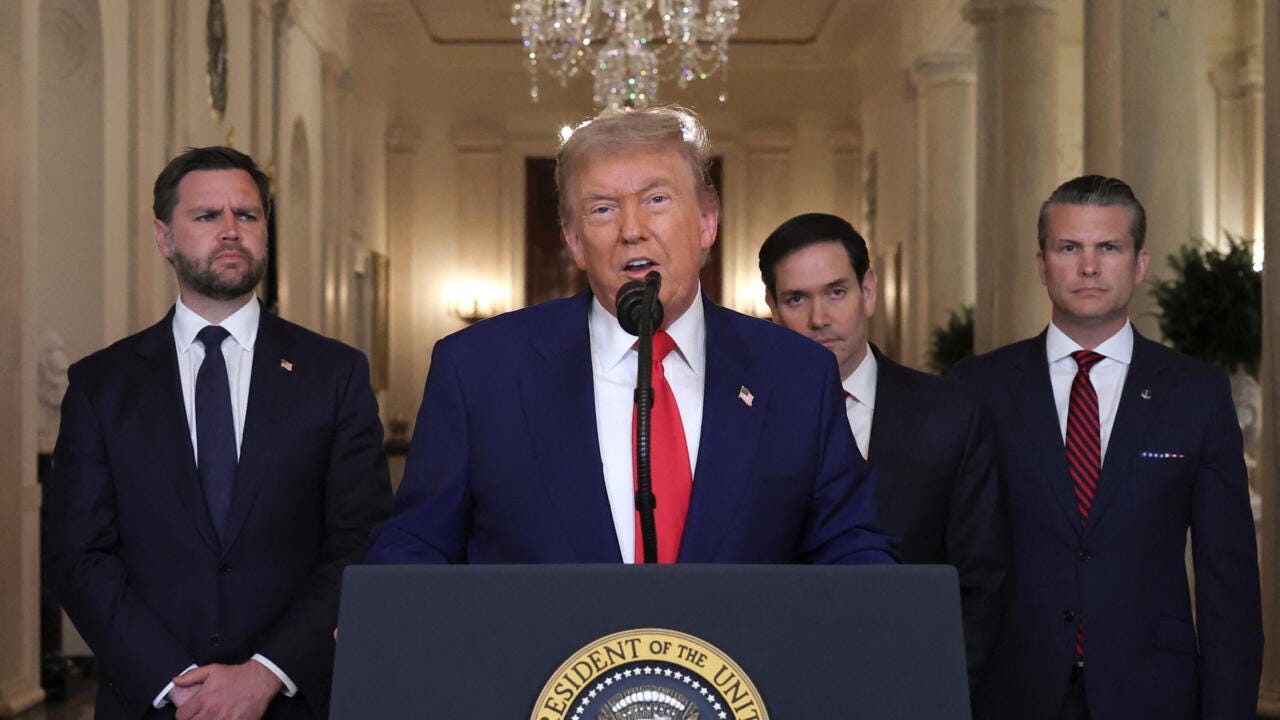BREAKING: U.S. just struck Iran. Iraq may just slip back into civil war because of it.
Iran-aligned militias across Iraq will inevitably take up arms amid the rising hostilities.

In a historic first, the United States has launched airstrikes against Iran.
The U.S. targeted nuclear facilities in Fordow, Natanz, and Isfahan, reportedly using B-2 stealth bombers launched from Whiteman Air Force Base in Missouri.
President Donald Trump declared the operation a “successful attack” in a post on Truth Social:
“We have completed our very successful attack on the three Nuclear sites in Iran, including Fordow, Natanz, and Esfahan. All planes are now outside of Iran air space. A full payload of BOMBS was dropped on the primary site, Fordow. All planes are safely on their way home. Congratulations to our great American Warriors. There is not another military in the World that could have done this. NOW IS THE TIME FOR PEACE! Thank you for your attention to this matter.”
Tensions are now high across the region. The U.S. strikes risk escalating what has thus far been an air war between Israel and Iran into a full-blown armed confrontation across the Middle East.
Iraq, in particular, may find itself in the crosshairs. As I explored in a previous article, Iran has deeply entrenched itself in Iraqi society and its security apparatus. Much of this has been enabled through the Popular Mobilization Forces (PMF)—a coalition of Shia Iraqi armed groups closely aligned with Tehran.
Following the initial strikes, Kataib Hezbollah—a leading militia within the PMF—warned against American intervention in the war between Israel and Iran, threatening to target U.S. assets in Iraq.
“We are closely monitoring the movements of the American enemy's army in the region,” said Kataib Hezbollah Secretary-General Abu Hussein al-Hamidawi. “If America intervenes in the war, we will act directly against its interests and bases spread across the region without hesitation.”
Saraya Awliya al-Dam, another pro-Iranian militia in Iraq alleged to be part of the PMF also issued a similar warning against Iran’s rivals.
These threats should not be taken lightly. Throughout 2024, Kataib Hezbollah and other Iran-aligned PMF factions frequently targeted U.S. forces and bases across Iraq in response to American support for Israel during the Gaza war.
According to a report from AP News, drones were launched at the Ain al-Asad airbase in Iraq’s Anbar province shortly after the current conflict broke out.
Yesterday, mass protests erupted in Sadr City, Baghdad, against Israel’s strikes on Iran. Organized by influential Shia cleric Muqtada al-Sadr, demonstrators chanted, “No to Israel! No to America!”
Sadr condemned what he called “Zionist and American terrorism” and “aggression against neighboring Iran, Palestine, Lebanon, Syria, and Yemen.”
Yet despite widespread hostility toward Israel, Iraqis are not universally pro-Iran. Sadr himself has long been critical of Iran’s influence in Iraq through its militia networks.
It’s worth noting that the PMF was initially formed in 2014 following calls by Grand Ayatollah Ali al-Sistani for Iraqis to take up arms against the Islamic State. Although the coalition has since evolved into a tool of Iranian power, Sistani remains a vocal critic of Tehran’s interference in Iraqi politics.
In his 2022 book Inside the Middle East: Entering a New Era, analyst Avi Melamed highlights a key intra-Shia divide in Iraq—between pro-Iranian factions that view the clerical regime in Tehran as their political compass, and nationalist Shia Iraqis who seek an independent Iraq free from Iranian domination.
This division became starkly visible during the 2019 Tishreen Movement, when massive protests called for political and economic reforms and an end to Iranian influence in Baghdad.
Should Kataib Hezbollah and the broader PMF follow through on their threats and attack U.S. assets, intra-Shia tensions could reach a boiling point. At a time when Iraq’s government is attempting to integrate the PMF into the formal security sector, such escalations could threaten the fragile stability of Iraqi governance.
While protests against Israel will likely continue, so too will calls for Iraqi non-involvement in the broader regional conflict. Clerics like Sadr and Sistani may renew their calls for sovereignty and repeat 2014’s rhetoric—urging Iraqis to take up arms, but this time possibly against fellow Shia factions.
These tensions would at first, largely be contained to the streets. As nationalist protests erupt, PMF forces may launch crackdowns against anti-Iranian activists. In
This could lead to a new, Shia-dominated insurgency. Other religious and ethnic communities—Sunnis, Kurds, and others—would inevitably be drawn into the conflict, each pursuing their own strategic goals.
What would heighten tensions would be direct involvement of outside actors within Iraq. Iran would most certainly step in to aid its allies in Iraq if they find themselves at threat of disintegration, potentially sending Islamic Revolutionary Guard Corps forces to support them, just as Tehran did in Syria.
Israel as well would take steps to countering these groups. Already, it’s been reported that Haydar al-Mousawi, security head of the Iran-aligned Kata'ib Sayyid al-Shuhada, was killed in an Israeli strike along the Iran-Iraq border.
A new civil war would also threaten to turn Iraq into a terror hub as the previous war of the mid-2000s did. That conflict saw Sunni Muslims from across the Islamic world travel to Iraq and join the Sunni-dominant insurgency, joining groups such as al-Qaeda. A similar outcome may occur again, attracting disaffected Shia Muslims from abroad, including those from states closely aligned with Iran.
Just today in Syria, an Islamic State suicide bombing occurred targeting a church in Damascus. According to Middle East & North Africa analyst Freddy Khoueiry, terror groups will aim to “exploit the region's distractions” to launch further attacks. With Islamic State sleeper cells still existent across Iraq, a comeback for the organization amid a new civil war—the previous one set the stage for the group’s rise—could take place.




